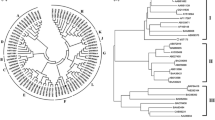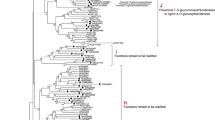Abstract
Key message
A novel isoflavone 7- O -glucosyltransferase PlUGT1 was isolated from Pueraria lobata . PlUGT1 could convert daidzein to daidzin, genistein to genistin as well as formononetin to ononin.
Abstract
Pueraria lobata roots are traditionally consumed as a rich source of isoflavone glycosides that have various human health benefits. However, to date, the genes encoding isoflavone UDP-glycosyltransferases (UGTs) have only been isolated from the roots of soybean seedlings (GmIF7GT), soybean seeds (UGT73F2) and Glycyrrhiza echinata cell suspension cultures (GeIF7GT). To investigate the isoflavone metabolism in P. lobata, 40 types of partial UGT cDNAs were isolated from P. lobata, and seven full-length UGT candidates with preferential expression in roots were identified. Functional assays in yeast (Saccharomyces cerevisiae) revealed that one of these UGT candidates, designated PlUGT1 (official UGT designation UGT88E12), efficiently glycosylated isoflavone aglycones at the 7-hydroxy group. Recombinant PlUGT1 purified from Escherichia coli cells was characterized and shown to be relatively specific for isoflavone aglycones, while flavonoid substrates were poorly accepted. The biochemical results suggested that PlUGT1 was an isoflavone 7-O-glucosyltransferase. The deduced amino acid sequence of PlUGT1 shared only 26 % identity with GeIF7GT, 27 % with UGT73F2 and 63 % with GmIF7GT. The PlUGT1 gene was highly expressed in P. lobata roots relative to other organs and strongly induced by methyl jasmonate signal in P. lobata cell suspension culture. The transcript abundance of PlUGT1 was correlated with the accumulation pattern of isoflavone glycosides such as daidzin in P. lobata plants or in cell suspension culture. The biochemical properties and gene expression profile supported the idea that PlUGT1 could play a role in isoflavone glycosylation in P. lobata.







Similar content being viewed by others
Abbreviations
- cDNAs:
-
Complementary DNAs
- HID:
-
Trihydroxyisoflavanone dehydratase
- HPLC:
-
High-performance liquid chromatography
- IFS:
-
Isoflavone synthase
- IPTG:
-
Isopropyl-D-thiogalactopyranoside
- LC–MS:
-
Liquid chromatography–mass spectrometry
- MeJA:
-
Methyl jasmonate
- MS:
-
Murashige and Skoog
- NAA:
-
Naphthalene acetic acid
- PSPG:
-
Putative secondary plant glycosyltransferase
- qRT-PCR:
-
Quantitative RT-PCR
- RACE:
-
Rapid-amplification of cDNA ends
- UGTs:
-
UDP-glycosyltransferases
References
Achnine L, Huhman DV, Farag MA, Sumner LW, Blount JW, Dixon RA (2005) Genomics-based selection and functional characterization of triterpene glycosyltransferases from the model legume Medicago truncatula. Plant J 41:875–887
Akashi T, Aoki T, Ayabe S (1999) Cloning and functional expression of a cytochrome P450 cDNA encoding 2-hydroxyisoflavanone synthase involved in biosynthesis of the isoflavonoid skeleton in licorice. Plant Physiol 121:821–828
Akashi T, Aoki T, Ayabe S (2005) Molecular and biochemical characterization of 2-hydroxyisoflavanone dehydratase. Involvement of carboxylesterase-like proteins in leguminous isoflavone biosynthesis. Plant Physiol 137:882–891
Alekel DL, Germain AS, Peterson CT, Hanson KB, Stewart JW, Toda T (2000) Isoflavone-rich soy protein isolate attenuates bone loss in the lumbar spine of perimenopausal women. Am J Clin Nutr 72:844–852
Auyeung KK, Law PC, Ko JK (2012) Novel anti-angiogenic effects of formononetin in human colon cancer cells and tumor xenograft. Oncol Rep 28:2188–2194
Boonsnongcheep P, Korsangruang S, Soonthornchareonnon N, Chintapakorn Y, Saralamp P, Prathanturarug S (2010) Growth and isoflavonoid accumulation of Pueraria candollei var. candollei and P. candollei var. mirifica cell suspension cultures. Plant Cell Tiss Organ Cult 101:119–126
Boue SM, Wiese TE, Nehls S, Burow ME, Elliott S, Carter-Wientjes CH, Shih BY, McLachlan JA, Cleveland TE (2003) Evaluation of the estrogenic effects of legume extracts containing phytoestrogens. J Agric Food Chem 51:2193–2199
Bowles D, Isayenkova J, Lim EK, Poppenberger B (2005) Glycosyltransferases: managers of small molecules. Curr Opin Plant Biol 8:254–263
Brazier-Hicks M, Evans KM, Gershater MC, Puschmann H, Steel PG, Edwards R (2009) The C-glycosylation of flavonoids in cereals. J Biol Chem 284:17926–17934
Chen F, Hao F, Li C, Gou J, Lu D, Gong F, Tang H, Zhang Y (2013) Identifying three ecological chemotypes of Xanthium strumarium glandular trichomes using a combined NMR and LC-MS method. PLoS One 8:e76621
Dakora FD, Joseph CM, Phillips DA (1993) Alfalfa (Medicago sativa L.) root exudates contain isoflavonoids in the presence of Rhizobium meliloti. Plant Physiol 101:819–824
Dhaubhadel S, Farhangkhoee M, Chapman R (2008) Identification and characterization of isoflavonoid specific glycosyltransferase and malonyltransferase from soybean seeds. J Exp Bot 59:981–994
Gietz RD, Woods RA (2002) Transformation of yeast by lithium acetate/single-stranded carrier DNA/polyethylene glycol method. Methods Enzymol 350:87–96
He X, Blount JW, Ge S, Tang Y, Dixon RA (2011) A genomic approach to isoflavone biosynthesis in kudzu (Pueraria lobata). Planta 233:843–855
Hirotani M, Kuroda R, Suzuki H, Yoshikawa T (2000) Cloning and expression of UDP-glucose: flavonoid 7-O-glucosyltransferase from hairy root cultures of Scutellaria baicalensis. Planta 210:1006–1013
Huang L, Li J, Ye H, Li C, Wang H, Liu B, Zhang Y (2012) Molecular characterization of the pentacyclic triterpenoid biosynthetic pathway in Catharanthus roseus. Planta 236:1571–1581
Hughes J, Hughes MA (1994) Multiple secondary plant product UDP-glucose glucosyltransferase genes expressed in cassava (Manihot esculenta Crantz) cotyledons. Mitochondrial DNA 5:41–49
Jin SE, Son YK, Min BS, Jung HA, Choi JS (2012) Anti-inflammatory and antioxidant activities of constituents isolated from Pueraria lobata roots. Arch Pharm Res 35:823–837
Jung W, Yu O, Lau SM, O’Keefe DP, Odell J, Fader G, McGonigle B (2000) Identification and expression of isoflavone synthase, the key enzyme for biosynthesis of isoflavones in legumes. Nat Biotechnol 18:208–212
Keung WM, Vallee BL (1998) Kudzu root: an ancient Chinese source of modern antidipsotropic agents. Phytochemistry 47:499–506
Keung WM, Lazo O, Kunze L, Vallee BL (1996) Potentiation of the bioavailability of daidzin by an extract of Radix puerariae. Proc Natl Acad Sci USA 93:4284–4288
Korsangruang S, Soonthornchareonnon N, Chintapakorn Y, Saralamp P, Prathanturarug S (2010) Effects of abiotic and biotic elicitors on growth and isoflavonoid accumulation in Pueraria candollei var. candollei and P. candollei var. mirifica cell suspension cultures. Plant Cell Tiss Organ Cult 103:333–342
Koster J, Barz W (1981) UDP-glucose: isoflavone 7-O-glucosyltransferase from roots of chick pea (Cicer arietinum L.). Arch Biochem Biophys 212:98–104
Lamartiniere CA (2000) Protection against breast cancer with genistein: a component of soy. Am J Clin Nutr 71:1705S–1707S Discussion 1708S–1709S
Larkin MA, Blackshields G, Brown NP, Chenna R, McGettigan PA, McWilliam H, Valentin F, Wallace IM, Wilm A, Lopez R, Thompson JD, Gibson TJ, Higgins DG (2007) Clustal W and Clustal X version 2.0. Bioinformatics 23:2947–2948
Lee JS (2004) Supplementation of Pueraria radix water extract on changes of antioxidant enzymes and lipid profile in ethanol-treated rats. Clin Chim Acta 347:121–128
Li G, Zhang Q, Wang Y (2010) Chemical constituents from roots of Pueraria lobata. Zhongguo Zhong Yao Za Zhi 35:3156–3160
Li Z-B, Li C-F, Li J, Zhang Y-S (2014) Molecular cloning and functional characterization of two divergent 4-coumarate: coenzyme A ligases from kudzu (Pueraria lobata). Biol Pharm Bull 37:113–122
Lin RC, Guthrie S, Xie CY, Mai K, Lee DY, Lumeng L, Li TK (1996) Isoflavonoid compounds extracted from Pueraria lobata suppress alcohol preference in a pharmacogenetic rat model of alcoholism. Alcohol Clin Exp Res 20:659–663
Merz-Demlow BE, Duncan AM, Wangen KE, Xu X, Carr TP, Phipps WR, Kurzer MS (2000) Soy isoflavones improve plasma lipids in normocholesterolemic, premenopausal women. Am J Clin Nutr 71:1462–1469
Modolo LV, Blount JW, Achnine L, Naoumkina MA, Wang X, Dixon RA (2007) A functional genomics approach to (iso)flavonoid glycosylation in the model legume Medicago truncatula. Plant Mol Biol 64:499–518
Murashige T, Skoog F (1962) A revised medium for rapid growth and bio assays with tobacco tissue cultures. Physiol Plant 15:473–497
Nagashima S, Inagaki R, Kubo A, Hirotani M, Yoshikawa T (2004) cDNA cloning and expression of isoflavonoid-specific glucosyltransferase from Glycyrrhiza echinata cell-suspension cultures. Planta 218:456–459
Nagatoshi M, Terasaka K, Nagatsu A, Mizukami H (2011) Iridoid-specific glucosyltransferase from Gardenia jasminoides. J Biol Chem 286:32866–32874
Noguchi A, Saito A, Homma Y, Nakao M, Sasaki N, Nishino T, Takahashi S, Nakayama T (2007) A UDP-glucose:isoflavone 7-O-glucosyltransferase from the roots of soybean (glycine max) seedlings. Purification, gene cloning, phylogenetics, and an implication for an alternative strategy of enzyme catalysis. J Biol Chem 282:23581–23590
Offen W, Martinez-Fleites C, Yang M, Kiat-Lim E, Davis BG, Tarling CA, Ford CM, Bowles DJ, Davies GJ (2006) Structure of a flavonoid glucosyltransferase reveals the basis for plant natural product modification. EMBO J 25:1396–1405
Paquette S, Moller BL, Bak S (2003) On the origin of family 1 plant glycosyltransferases. Phytochemistry 62:399–413
Pompon D, Louerat B, Bronine A, Urban P (1996) Yeast expression of animal and plant P450s in optimized redox environments. Methods Enzymol 272:51–64
Sambrook J, Russell DW (2001) Molecular cloning: a laboratory manual, vol 1, 3rd edn. Cold Spring Harbor Laboratory Press, Cold Spring Harbor
Sawada S, Suzuki H, Ichimaida F, Yamaguchi MA, Iwashita T, Fukui Y, Hemmi H, Nishino T, Nakayama T (2005) UDP-glucuronic acid: anthocyanin glucuronosyltransferase from red daisy (Bellis perennis) flowers. Enzymology and phylogenetics of a novel glucuronosyltransferase involved in flower pigment biosynthesis. J Biol Chem 280:899–906
Shao H, He X, Achnine L, Blount JW, Dixon RA, Wang X (2005) Crystal structures of a multifunctional triterpene/flavonoid glycosyltransferase from Medicago truncatula. Plant Cell 17:3141–3154
Steele CL, Gijzen M, Qutob D, Dixon RA (1999) Molecular characterization of the enzyme catalyzing the aryl migration reaction of isoflavonoid biosynthesis in soybean. Arch Biochem Biophys 367:146–150
Tamura K, Stecher G, Peterson D, Filipski A, Kumar S (2013) MEGA6: molecular evolutionary genetics analysis version 6.0. Mol Biol Evol 30:2725–2729
Thiem B (2003) In vitro propagation of isoflavone-producing Pueraria lobata (Willd.) Ohwi. Plant Sci 165:1123–1128
Wu HQ, Guo HN, Wang HQ, Chang MZ, Zhang GL, Zhao YX (2009) Protective effects and mechanism of puerarin on learning-memory disorder after global cerebral ischemia-reperfusion injury in rats. Chin J Integr Med 15:54–59
Yasuda T, Endo M, Kon-no T, Kato T, Mitsuzuka M, Ohsawa K (2005) Antipyretic, analgesic and muscle relaxant activities of pueraria isoflavonoids and their metabolites from Pueraria lobata Ohwi-a traditional Chinese drug. Biol Pharm Bull 28:1224–1228
Yu H-S, Ma L-Q, Zhang J-X, Shi G-L, Hu Y-H, Wang Y-N (2011) Characterization of glycosyltransferases responsible for salidroside biosynthesis in Rhodiola sachalinensis. Phytochemistry 72:862–870
Zhang FR, Chen JZ, Zhu JH, Wang XX, Shang YP, Guo XG, Dai HM, Sun J (2004) Effects of puerarin on number and activity of endothelial progenitor cells from peripheral blood. Zhongguo Zhong Yao Za Zhi 29:777–781
Zhao C, Chan HY, Yuan D, Liang Y, Lau TY, Chau FT (2011) Rapid simultaneous determination of major isoflavones of Pueraria lobata and discriminative analysis of its geographical origins by principal component analysis. Phytochem Anal 22:503–508
Acknowledgments
This project was partially supported by the National Natural Science Foundation of China (Project No. 31170284), the Grant for One Hundred Talents Program of the Chinese Academy of Sciences, China (Project No. Y129441R01) and the Innovation Project of Chinese Academy of Science (Project No. KSCX2-EW-J-20).
Conflict of interest
The authors declare that they have no conflict of interests.
Author information
Authors and Affiliations
Corresponding author
Additional information
Communicated by C. F. Quiros.
J. Li and Z. Li contributed equally to this work.
Electronic supplementary material
Below is the link to the electronic supplementary material.
Rights and permissions
About this article
Cite this article
Li, J., Li, Z., Li, C. et al. Molecular cloning and characterization of an isoflavone 7-O-glucosyltransferase from Pueraria lobata . Plant Cell Rep 33, 1173–1185 (2014). https://doi.org/10.1007/s00299-014-1606-7
Received:
Revised:
Accepted:
Published:
Issue Date:
DOI: https://doi.org/10.1007/s00299-014-1606-7




